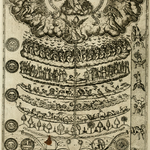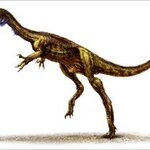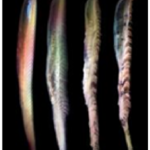Paleontology

A traditional Chinese extract from the bark of the magnolia tree, an ancient genus that goes back some 95-million years, gives you fresh breath by killing off the nasty oral microbes that cause halitosis.
My favorite individual tree is the magnolia growing on the grounds at Balboa Park. It is a magnificent example of the family Magnoliaceae and takes up nearly a whole city block. Older magnolia have this elegant quality of long draping branches, perfect for avoiding a predator while enjoying an afternoon's snooze.
Given that our ancestors decended from the trees, pre Lucy now it seems, and…

A new dinosaur named Brontomerus mcintoshi, 'thunder-thighs' to its discoverers because of its powerful thigh muscles, has been described in a paper in the journal Acta Palaeontologica Polonica.
A member of the long-necked sauropod group of dinosaurs which includes Diplodocus and Brachiosaurus, Brontomerus may have used its powerful thighs as a weapon to kick predators, or less interestingly, to help travel over rough terrain. Brontomerus lived about 110 million years ago, during the Early Cretaceous Period, and probably had to contend with fierce raptors such as Deinonychus and…
Faked fossils hold up science; there’s no two ways about it. Palaeontologists need a thick skin to realize that sometimes, those hours spent examining and interpreting a fossil may have been entirely wasted.
Sometimes, although the fossil may have been tampered with, the work may not have been wholly in vain, and there may be still viable science that can be done. And sometimes, like in this week's hoaxed fossil, there can be a whole new family of dinosaurs to describe.
Brazil and its fossils
The fraudulent fossil from this week's article hails from the Santana formation of Brazil, which has…

The comments thread for an article that I wrote a couple of weeks ago has suddenly been swamped by the replies of a young-earth creationist. Perhaps I should have expected it, with an article about hoaxed fossils. He presents an orgy of anecdotes that he claims (I assume it's a he) debunks my evolutionist agenda.
I say orgy: its a bacchanalian romp of differing misconceptions and twisted logic - basically, nothing out of the ordinary for a creationist, for whom apparently the addition of even more terrible ideas can only strengthen your argument. Very quickly, I got bored of the tedious…

Did dinosaurs appear and replace other animals? At least in one South American valley, there's no indication that the dinosaurs appeared and wiped out other animals, which has been the prevailing hypothesis for the origin of dinosaurs based on fossils from North America and elsewhere in the world.
Dating of new dinosaur fossils and volcanic ash around them by researchers from has led them to cast doubt on the idea that dinosaurs appeared and opportunistically replaced other animals. They seem to have existed side by side and gone through similar periods of extinction.
Geologists…

A new fossil cephalopod has turned up in the news! It's funny cuz I was just pondering ammonites recently.
"It is a new species of squid, totally new, that has not been seen in
other parts of the world," paleontologist Klaus Honninger told AFP. Honninger,
director of the Meyer-Honninger Paleontology Museum in the northern
city of Chiclayo, said the fossil was a large cephalopod of the extinct
Baculite species, known for their long straight shells.
Wait a minute--if it's a totally new species of squid, how can it be a member of an extinct species? As usual, reporting is a bit muddled.…

In a piece by Richard Stone in this week’s Science, it was pointed out that in Chinese Museums, it is likely that up to 80% of the marine reptiles on display have been altered or artificially combined to some degree. This seems like a shocking figure, but it is more understandable when it is considered that few of these museums have palaeontologists as staff, and that many of these fossils are unearthed by Chinese farmers that dress their finds up so that a museum is more likely to buy them. Of late there has been a boom, both in the numbers of museums, but also in the acquisition funds set…

Is the lack of complex anatomical features in fossils of primitive vertebrates absence of evidence or evidence of absence? And how would we tell? Hoping to answer this, a team of palaeontologists at the University of Leicester, UK, have set out to do the seemingly impossible: place error bars on the interpretations of simple vertebrate fossils, by studying the decay of modern simple vertebrate animals. The result, from work carried throughout the year, had slightly embarrassing implications for our former interpretations of primitive vertebrates and has forced a paradigm shift in the way we…

Colin Palmer, an engineer engaged in research on the aerodynamics of pterosaurs at the University of Bristol, has shown that the creatures were predominantly adapted to slow speed flight; too slow and flexible to use, or survive in, the stormy winds of some oceans, such as the albatross does in the southern oceans
Pterosaur wings had variable geometry and that, combined with their slow flight enabled them to land very gently, reducing the chance of damage to their thin bones. This goes a long way to explaining how pterosaurs became the largest flying creatures ever known, with a wingspan up…
A new paper suggests that instead of some primates evolving in Africa and spreading out from there, they colonized it, likely from Asia. The search for data regarding the origins of man's earliest anthropoid ancestors is obviously one of the most hotly pursued subjects in paleontology.
Anthropoids are the primate group that includes humans, apes, and monkeys and it has been widely accepted that they evolved in Africa but a team of paleontologists say new fossils discovered at the Dur At-Talah escarpment in central Libya presents the case that the diversity of species present, three…